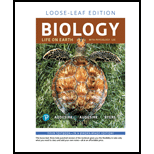
Pearson eText Biology: Life on Earth with Physiology -- Instant Access (Pearson+)
12th Edition
ISBN: 9780135755785
Author: Gerald Audesirk, Teresa Audesirk
Publisher: PEARSON+
expand_more
expand_more
format_list_bulleted
Concept explainers
Question
Chapter 28, Problem 2RQ
Summary Introduction
To explain:
The way through which resource partitioning is a logical outcome of the competitive exclusion principle.
Introduction:
The competitive exclusion principle determines that no species differentiation is occurring in such area where resource partitioning occurs between species. Each of the species needs a set of
Expert Solution & Answer
Want to see the full answer?
Check out a sample textbook solution
Students have asked these similar questions
The Sentinel Cell: Nature’s Answer to Cancer?
Molecular Biology Question
You are working to characterize a novel protein in mice. Analysis shows that high levels of the primary transcript that codes for this protein are found in tissue from the brain, muscle, liver, and pancreas. However, an antibody that recognizes the C-terminal portion of the protein indicates that the protein is present in brain, muscle, and liver, but not in the pancreas. What is the most likely explanation for this result?
Molecular Biology
Explain/discuss how “slow stop” and “quick/fast stop” mutants wereused to identify different protein involved in DNA replication in E. coli.
Chapter 28 Solutions
Pearson eText Biology: Life on Earth with Physiology -- Instant Access (Pearson+)
Ch. 28.1 - Prob. 1CYLCh. 28.1 - Prob. 2CYLCh. 28.2 - Prob. 1CSCCh. 28.2 - Prob. 1CTCh. 28.2 - Prob. 1CYLCh. 28.2 - explain how competitive exclusion leads to...Ch. 28.2 - explain how interspecific competition can affect...Ch. 28.3 - Prob. 1TCCh. 28.3 - Prob. 1HYEWCh. 28.3 - Prob. 2TC
Ch. 28.3 - Prob. 3TCCh. 28.3 - Prob. 1CYLCh. 28.3 - Prob. 2CYLCh. 28.3 - Prob. 3CYLCh. 28.3 - Prob. 4CYLCh. 28.3 - Prob. 5CYLCh. 28.4 - Prob. 1TCCh. 28.4 - describe some mutualistic interactions and how...Ch. 28.4 - Prob. 2CYLCh. 28.5 - Prob. 1CSCCh. 28.5 - Prob. 1CYLCh. 28.5 - Prob. 2CYLCh. 28.6 - People have suppressed fires for decades. How...Ch. 28.6 - Prob. 2TCCh. 28.6 - explain the process of succession and its general...Ch. 28.6 - describe primary succession and secondary...Ch. 28.6 - explain what a climax community is and what a...Ch. 28.6 - Prob. 3TCCh. 28 - Prob. 1MCCh. 28 - Which of the following statements is not true of...Ch. 28 - Prob. 3MCCh. 28 - Prob. 4MCCh. 28 - Prob. 5MCCh. 28 - Prob. 1FIBCh. 28 - Prob. 2FIBCh. 28 - Prob. 3FIBCh. 28 - Prob. 4FIBCh. 28 - Prob. 5FIBCh. 28 - Prob. 6FIBCh. 28 - Define an ecological community, and describe the...Ch. 28 - Prob. 2RQCh. 28 - Prob. 3RQCh. 28 - Prob. 4RQCh. 28 - Provide examples of two climax and two subclimax...Ch. 28 - Prob. 6RQCh. 28 - Prob. 7RQCh. 28 - Prob. 1ACCh. 28 - Prob. 2ACCh. 28 - Prob. 3AC
Knowledge Booster
Learn more about
Need a deep-dive on the concept behind this application? Look no further. Learn more about this topic, biology and related others by exploring similar questions and additional content below.Similar questions
- Molecular Biology Question A gene that codes for a protein was removed from a eukaryotic cell and inserted into a prokaryotic cell. Although the gene was successfully transcribed and translated, it produced a different protein than it produced in the eukaryotic cell. What is the most likely explanation?arrow_forwardMolecular Biology LIST three characteristics of origins of replicationarrow_forwardMolecular Biology Question Please help. Thank you For E coli DNA polymerase III, give the structure and function of the b-clamp sub-complex. Describe how the structure of this sub-complex is important for it’s function.arrow_forward
- Molecular Biology LIST three characteristics of DNA Polymerasesarrow_forwardMolecular Biology RNA polymerase core enzyme structure contains what subunits? To form holo enzyme, sigma factor is added to core. What is the name of the structure formed? Give the detailed structure of sigma factor and the function of eachdomain. Please help. Thank youarrow_forwardMolecular Biology You have a single bacterial cell whose DNA is labelled with radioactiveC14. After 5 rounds of cell division, how may cells will contain radioactive DNA? Please help. Thank youarrow_forward
- 1. Explain the structure and properties of atoms and chemical bonds (especially how they relate to DNA and proteins). Also add some pictures.arrow_forward1. In the Sentinel Cell DNA integrity is preserved through nanoscopic helicase-coordinated repair, while lipids in the membrane are fortified to resist environmental mutagens. also provide pictures for this question.arrow_forwardExplain the structure and properties of atoms and chemical bonds (especially how they relate to DNA and proteins). Also add some pictures.arrow_forward
- In the Sentinel Cell DNA integrity is preserved through nanoscopic helicase-coordinated repair, while lipids in the membrane are fortified to resist environmental mutagens. also provide pictures for this question.arrow_forward1. Explain how genetic information is stored, copied, transferred, and expressed. Also add some pictures for this question.arrow_forward!. Describe biological macromolecules (DNA, RNA, proteins, lipids, etc.) and how they function in the cell. also provide some images for this question.arrow_forward
arrow_back_ios
SEE MORE QUESTIONS
arrow_forward_ios
Recommended textbooks for you
 Concepts of BiologyBiologyISBN:9781938168116Author:Samantha Fowler, Rebecca Roush, James WisePublisher:OpenStax College
Concepts of BiologyBiologyISBN:9781938168116Author:Samantha Fowler, Rebecca Roush, James WisePublisher:OpenStax College Biology (MindTap Course List)BiologyISBN:9781337392938Author:Eldra Solomon, Charles Martin, Diana W. Martin, Linda R. BergPublisher:Cengage Learning
Biology (MindTap Course List)BiologyISBN:9781337392938Author:Eldra Solomon, Charles Martin, Diana W. Martin, Linda R. BergPublisher:Cengage Learning Biology Today and Tomorrow without Physiology (Mi...BiologyISBN:9781305117396Author:Cecie Starr, Christine Evers, Lisa StarrPublisher:Cengage Learning
Biology Today and Tomorrow without Physiology (Mi...BiologyISBN:9781305117396Author:Cecie Starr, Christine Evers, Lisa StarrPublisher:Cengage Learning Human Biology (MindTap Course List)BiologyISBN:9781305112100Author:Cecie Starr, Beverly McMillanPublisher:Cengage Learning
Human Biology (MindTap Course List)BiologyISBN:9781305112100Author:Cecie Starr, Beverly McMillanPublisher:Cengage Learning

Concepts of Biology
Biology
ISBN:9781938168116
Author:Samantha Fowler, Rebecca Roush, James Wise
Publisher:OpenStax College

Biology (MindTap Course List)
Biology
ISBN:9781337392938
Author:Eldra Solomon, Charles Martin, Diana W. Martin, Linda R. Berg
Publisher:Cengage Learning


Biology Today and Tomorrow without Physiology (Mi...
Biology
ISBN:9781305117396
Author:Cecie Starr, Christine Evers, Lisa Starr
Publisher:Cengage Learning

Human Biology (MindTap Course List)
Biology
ISBN:9781305112100
Author:Cecie Starr, Beverly McMillan
Publisher:Cengage Learning

GCSE Biology - Adaptations #79; Author: Cognito;https://www.youtube.com/watch?v=tC-u8xcZYSM;License: Standard Youtube License